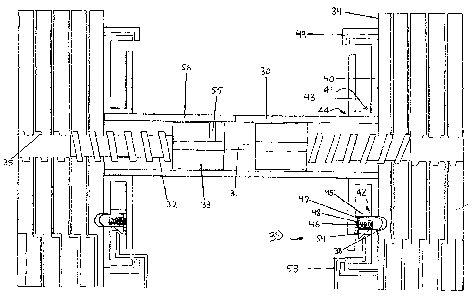Some of the information on this Web page has been provided by external sources. The Government of Canada is not responsible for the accuracy, reliability or currency of the information supplied by external sources. Users wishing to rely upon this information should consult directly with the source of the information. Content provided by external sources is not subject to official languages, privacy and accessibility requirements.
Any discrepancies in the text and image of the Claims and Abstract are due to differing posting times. Text of the Claims and Abstract are posted:
| (12) Patent Application: | (11) CA 2590272 |
|---|---|
| (54) English Title: | DUMBBELL ADJUSTING SYSTEM |
| (54) French Title: | SYSTEME DE REGLAGE D'HALTERES |
| Status: | Deemed Abandoned and Beyond the Period of Reinstatement - Pending Response to Notice of Disregarded Communication |
| (51) International Patent Classification (IPC): |
|
|---|---|
| (72) Inventors : |
|
| (73) Owners : |
|
| (71) Applicants : |
|
| (74) Agent: | SMART & BIGGAR LP |
| (74) Associate agent: | |
| (45) Issued: | |
| (86) PCT Filing Date: | 2005-12-13 |
| (87) Open to Public Inspection: | 2006-06-22 |
| Availability of licence: | N/A |
| Dedicated to the Public: | N/A |
| (25) Language of filing: | English |
| Patent Cooperation Treaty (PCT): | Yes |
|---|---|
| (86) PCT Filing Number: | PCT/US2005/045174 |
| (87) International Publication Number: | WO 2006065864 |
| (85) National Entry: | 2007-06-12 |
| (30) Application Priority Data: | ||||||
|---|---|---|---|---|---|---|
|
A dumbbell adjusting system comprises an adjusting system, a stand, and a
locking mechanism. The adjusting system includes two rods on the dumbbell's
handle which move in and out of the handle to selectively engage the inner
threaded through holes of the weights. The weights are configured to interlock
with one another so as not to move independently. The locking mechanism
unlocks the weights from the handle when the dumbbell is in the stand,
allowing the user to select the desired weight, and locks the weights into the
handle when the dumbbell is lifted out of the stand.
L'invention concerne un système de réglage d'haltères qui comprend un système de réglage, un support, et un mécanisme de verrouillage. Le système de réglage comporte deux tiges installées sur la poignée de l'haltère qui se déplacent dans et hors de ladite poignée de façon à mettre en prise sélectivement les trous filetés traversants internes des poids. Ces derniers sont configurés de façon à se verrouiller les uns aux autres et à ne pas bouger de manière indépendante. Le mécanisme de verrouillage débloque les poids de la poignée lorsque l'haltère est sur le support, ce qui permet à l'utilisateur de choisir le poids désiré, et bloque les poids dans la poignée lorsque l'haltère est soulevé hors du support.
Note: Claims are shown in the official language in which they were submitted.
Note: Descriptions are shown in the official language in which they were submitted.

2024-08-01:As part of the Next Generation Patents (NGP) transition, the Canadian Patents Database (CPD) now contains a more detailed Event History, which replicates the Event Log of our new back-office solution.
Please note that "Inactive:" events refers to events no longer in use in our new back-office solution.
For a clearer understanding of the status of the application/patent presented on this page, the site Disclaimer , as well as the definitions for Patent , Event History , Maintenance Fee and Payment History should be consulted.
| Description | Date |
|---|---|
| Time Limit for Reversal Expired | 2011-12-13 |
| Application Not Reinstated by Deadline | 2011-12-13 |
| Inactive: Abandon-RFE+Late fee unpaid-Correspondence sent | 2010-12-13 |
| Deemed Abandoned - Failure to Respond to Maintenance Fee Notice | 2010-12-13 |
| Letter Sent | 2008-02-19 |
| Reinstatement Requirements Deemed Compliant for All Abandonment Reasons | 2008-01-24 |
| Deemed Abandoned - Failure to Respond to Maintenance Fee Notice | 2007-12-13 |
| Letter Sent | 2007-11-05 |
| Inactive: Single transfer | 2007-09-12 |
| Inactive: Cover page published | 2007-08-30 |
| Inactive: Notice - National entry - No RFE | 2007-08-28 |
| Inactive: First IPC assigned | 2007-07-05 |
| Application Received - PCT | 2007-07-04 |
| National Entry Requirements Determined Compliant | 2007-06-12 |
| Application Published (Open to Public Inspection) | 2006-06-22 |
| Abandonment Date | Reason | Reinstatement Date |
|---|---|---|
| 2010-12-13 | ||
| 2007-12-13 |
The last payment was received on 2009-11-23
Note : If the full payment has not been received on or before the date indicated, a further fee may be required which may be one of the following
Please refer to the CIPO Patent Fees web page to see all current fee amounts.
| Fee Type | Anniversary Year | Due Date | Paid Date |
|---|---|---|---|
| Basic national fee - standard | 2007-06-12 | ||
| Registration of a document | 2007-09-12 | ||
| MF (application, 2nd anniv.) - standard | 02 | 2007-12-13 | 2008-01-24 |
| Reinstatement | 2008-01-24 | ||
| MF (application, 3rd anniv.) - standard | 03 | 2008-12-15 | 2008-09-16 |
| MF (application, 4th anniv.) - standard | 04 | 2009-12-14 | 2009-11-23 |
Note: Records showing the ownership history in alphabetical order.
| Current Owners on Record |
|---|
| ATD SERVICES, LLC |
| Past Owners on Record |
|---|
| ADAM T. DOUDIET |